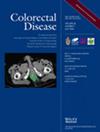Faecal calprotectin (FC) is a noninvasive marker that reflects intestinal inflammation with good sensitivity. A prior study indicated that FC values above 150 μg/g could distinguish between anal fistulas (AF) of cryptoglandular or Crohn's disease (CD) origin. It is hypothesized as a useful triage test to rule out CD in newly referred AF patients, thus reducing the number of ileocolonoscopies performed and optimizing treatment regimens in AF while minimizing patient discomfort as well as healthcare costs. The aim of the study was to determine the accuracy of FC in distinguishing between anal fistulas of cryptoglandular and CD origin, as well as compare characteristics in fistulas.
Patients referred with anal fistula who had an FC measurement and either ileocolonoscopy or colonoscopy within 12 weeks were included. Demographic and clinical characteristics were registered. Area under the curve (AUC) was calculated as well as sensitivity, specificity, positive predictive value (PPV), negative predictive value (NPV), and overall accuracy.
A total of 63 patients were included (CD n = 31, 49%). FC was significantly higher in CD compared to cryptoglandular fistulas, even when CD was medically treated or had no luminal activity on endoscopy. FC ≥110 μg/g was significantly associated with CD (OR 12.5; 95% CI: 3.77–41.4) p < 0.0001. This was found by plotting a receiver operating characteristic (ROC) curve, with AUC 80.8 (95% CI: 0.6952–0.9217). Sensitivity and specificity were 0.76 and 0.80, respectively (PPV 76%, NPV 80% and accuracy 78%).
FC discriminates CD from cryptoglandular fistulas, even in medically treated CD with normal endoscopic findings.


